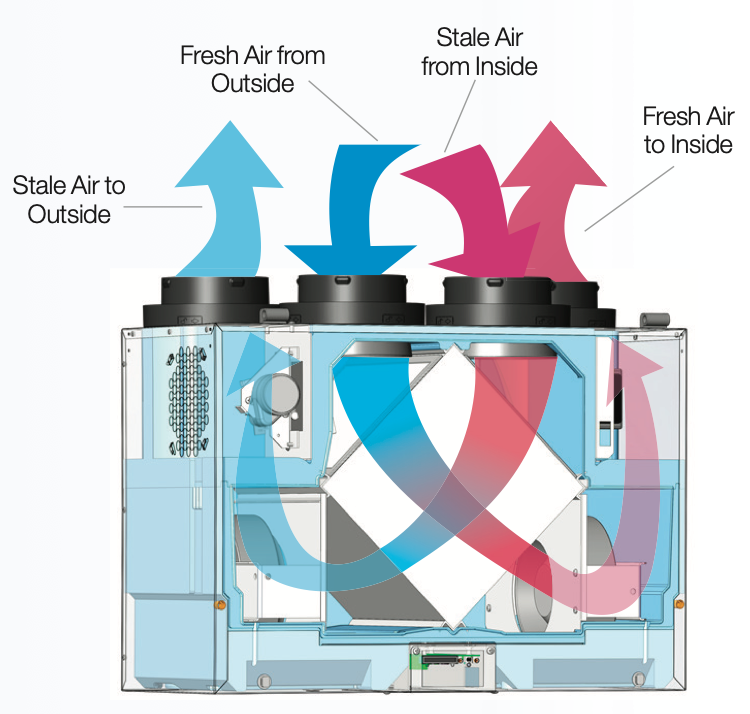Financial Benefits of HRV for Homeowners
Wiki Article
Exploring the Advantages of Heat Recovery Ventilation for Energy Efficiency in Residences
Heat Recovery Ventilation (HRV) systems use home owners a sensible method to enhancing power effectiveness. By recovering heat from outgoing air, these systems can substantially minimize heating & cooling expenses. In addition, they provide a consistent supply of fresh air, boosting interior air high quality and comfort levels. As house owners take into consideration lasting options, recognizing the nuances of HRV systems becomes progressively crucial. What variables should one evaluate before making such an investment?Comprehending Heat Recovery Ventilation Equipments

Exactly How HRV Enhances Indoor Air High Quality

Energy Cost Savings: The Monetary Advantages of HRV
Maximizing power performance, heat recovery ventilation (HRV) systems supply significant economic advantages for property owners. By recuperating and reusing heat from exhaust air, HRVs substantially reduce heating and cooling expenses. This innovation can result in energy financial savings of approximately 30%, depending on climate and use patterns. Home owners frequently discover minimized energy expenses soon after setup, making HRVs an economically smart investment over time. Furthermore, several regions supply motivations or refunds for energy-efficient upgrades, even more enhancing the monetary allure. As energy prices remain to increase, the cost-effectiveness of HRVs comes to be progressively clear. In general, the consolidation of HRV systems not only promotes energy performance but also contributes to long-lasting financial savings for households.The Environmental Impact of Heat Recovery Ventilation
A considerable environmental advantage of heat recovery ventilation (HRV) systems exists in their ability to lower general energy consumption. By recovering warmth from exhaust air and transferring it to incoming fresh air, HRV systems reduce the need for energy-intensive heating and cooling approaches. This reduction in energy demand adds to decrease greenhouse gas exhausts, as less nonrenewable fuel source HRV Heat Recovery Ventilation is required to maintain comfortable interior temperatures. Additionally, HRV systems enhance interior air high quality by effectively exchanging stale air with fresh outdoor air, minimizing reliance on mechanical cooling systems that can harm the environment. On the whole, the execution of HRV systems sustains sustainable living methods and aligns with worldwide efforts to deal with environment modification by advertising energy efficiency in domestic setups.
Choosing the Right HRV System for Your Home
Exactly how can property owners ensure they select the appropriate heat recovery ventilation (HRV) system for their requirements? They need to examine their home's size and layout, as these factors influence airflow requirements. Next off, assessing the system's effectiveness rankings is essential, as greater scores show much better efficiency and power savings. Property owners ought to also take into consideration installment and maintenance prices, comparing various brand names and versions for worth. In addition, it's essential to review noise levels, as some systems run even more quietly than others. Consulting with a/c professionals can give customized referrals based on details home conditions. Analyzing customer testimonials and warranties can aid in making a notified choice, making certain that the picked HRV system effectively improves interior air quality and power effectiveness.Regularly Asked Questions

Just how Often Should I Clean or Keep My HRV System?
The regularity of cleansing or maintaining a warmth healing ventilation (HRV) system generally depends on use and environmental aspects. Usually, it is recommended to execute maintenance every six months to ensure peak efficiency and air top quality.
Can HRV Systems Help In Reducing Moisture Levels Inside Your Home?
HRV systems can properly reduce indoor moisture degrees by exchanging stale, moist air with fresh, drier air from outside. HRV Heat Recovery Ventilation. This procedure helps maintain a well balanced interior setting, enhancing comfort and protecting against moisture-related issues
What Is the Life expectancy of a Common HRV System?
The life expectancy of a normal heat recovery ventilation (HRV) system differs, usually lasting in between 10 to 15 years. Regular upkeep can extend its efficiency and functional life, making certain peak efficiency throughout its use duration.Exist Any Sound Issues With HRV Solutions?
Sound problems with HRV systems can develop, especially from follower procedure. However, lots of contemporary devices are designed to reduce audio degrees, ensuring they operate silently while maintaining efficiency, which resolves potential disruptions in living settings.Can I Mount an HRV System Myself, or Do I Required a Specialist?
The individual contemplated whether to mount the heat recovery ventilation (HRV) system personally or employ an expert. Normally, while do it yourself setup is feasible, knowledge assurances correct functionality and compliance with local building codes, improving system performance.Report this wiki page